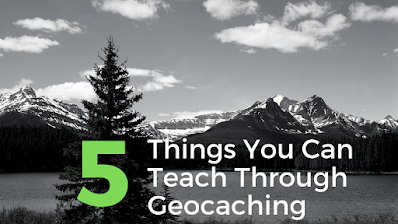
16 Apr Five Things You Can Teach Through Geocaching
Geocaching is one of the things that I spend a good bit of time talking about in both my workshop and in my webinar about blending technology into outdoor learning. Geocaching is a great activity to do to get kids outside for hands-on learning experiences. Here are five things that you can teach through geocaching activities.
Geospatial Awareness
The core of geocaching activities is locating hidden caches. This can be done through the use of GPS (either on a phone, a smartwatch, or on a dedicated GPS unit) or in an “old school” method of using maps. Finding a cache can require students to have an understanding of the distance between two or more places.
Cardinal Direction
Do your students know in which direction to turn if you tell them to walk north? Teach them about cardinal direction through geocaching activities. You can set up geocaching activities in and around your school yard that don’t require students to use any electronic devices. Simply make a map or make a list of clues that give students information about the directions and distances they need to go in order to find a series of caches.
Earth Science
Let students test use their knowledge of rock types or plant types as they seek geocaches. You can incorporate a little civic duty into the lesson by asking students to pick up litter they find while geocaching.
Citizenship
If you or your students use the official Geocaching website to find caches in your area, you may find some that border on private property. This is an opportunity to teach students about respecting the property of others. Another opportunity to teach a lesson about citizenship is found in playing by the rules of geocaching. For example, students shouldn’t move caches they’ve found.
Digital Citizenship
As with any activity that incorporates an online, public-facing component participating in official Geocaching activities provides us with a good opportunity to review the basics of good digital citizenship. Students who are placing caches for inclusion on the public listings of Geocaches need to be mindful of not including personally identifying and other sensitive information in their descriptions and hints.
Bonus item: It’s hard for me to talk about geocaching without thinking about a couple of classic “geography songs.” Enjoy!
Learn how to make more money this year by creating and selling your own digital products. Enroll in How to Create & Sell Your Own Digital Products today!
Geocaching is one of the things that I spend a good bit of time talking about in both my workshop and in my webinar about blending technology into outdoor learning. Geocaching is a great activity to do to get kids outside for hands-on learning experiences. Here are five things that you can teach through geocaching activities.
Geospatial Awareness
The core of geocaching activities is locating hidden caches. This can be done through the use of GPS (either on a phone, a smartwatch, or on a dedicated GPS unit) or in an “old school” method of using maps. Finding a cache can require students to have an understanding of the distance between two or more places.
Cardinal Direction
Do your students know in which direction to turn if you tell them to walk north? Teach them about cardinal direction through geocaching activities. You can set up geocaching activities in and around your school yard that don’t require students to use any electronic devices. Simply make a map or make a list of clues that give students information about the directions and distances they need to go in order to find a series of caches.
Earth Science
Let students test use their knowledge of rock types or plant types as they seek geocaches. You can incorporate a little civic duty into the lesson by asking students to pick up litter they find while geocaching.
Citizenship
If you or your students use the official Geocaching website to find caches in your area, you may find some that border on private property. This is an opportunity to teach students about respecting the property of others. Another opportunity to teach a lesson about citizenship is found in playing by the rules of geocaching. For example, students shouldn’t move caches they’ve found.
Digital Citizenship
As with any activity that incorporates an online, public-facing component participating in official Geocaching activities provides us with a good opportunity to review the basics of good digital citizenship. Students who are placing caches for inclusion on the public listings of Geocaches need to be mindful of not including personally identifying and other sensitive information in their descriptions and hints.
Bonus item: It’s hard for me to talk about geocaching without thinking about a couple of classic “geography songs.” Enjoy!
Learn how to make more money this year by creating and selling your own digital products. Enroll in How to Create & Sell Your Own Digital Products today! Free Technology For Teachers, Geocaching, Geography, how to, Social Studies, webinarRead More
Free Technology For Teachers, Geocaching, Geography, how to, Social Studies, webinarRead More


Sorry, the comment form is closed at this time.